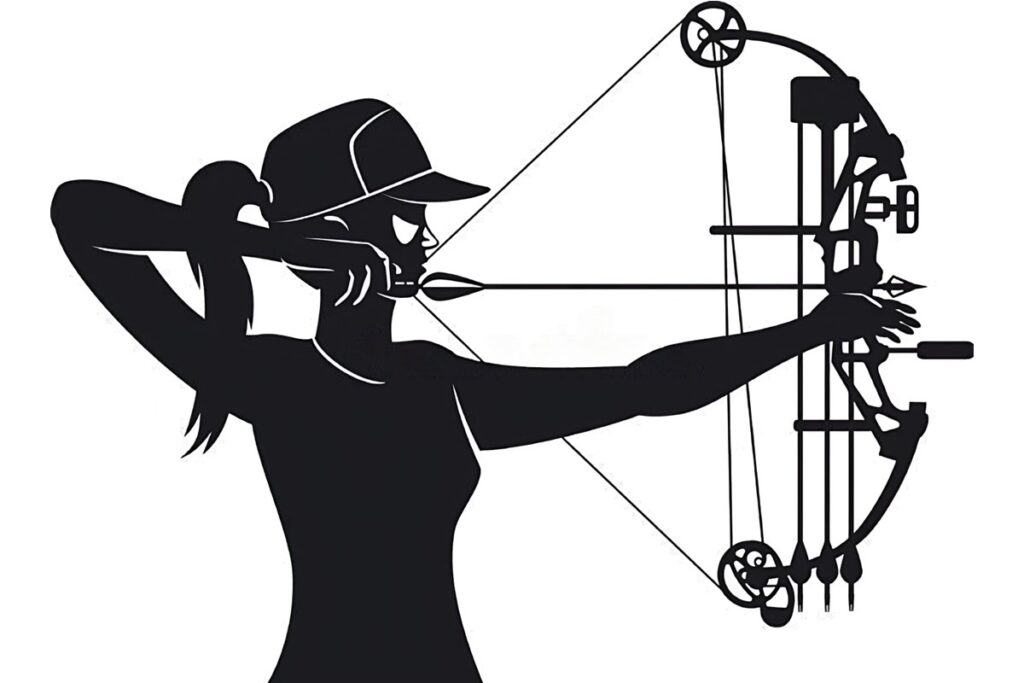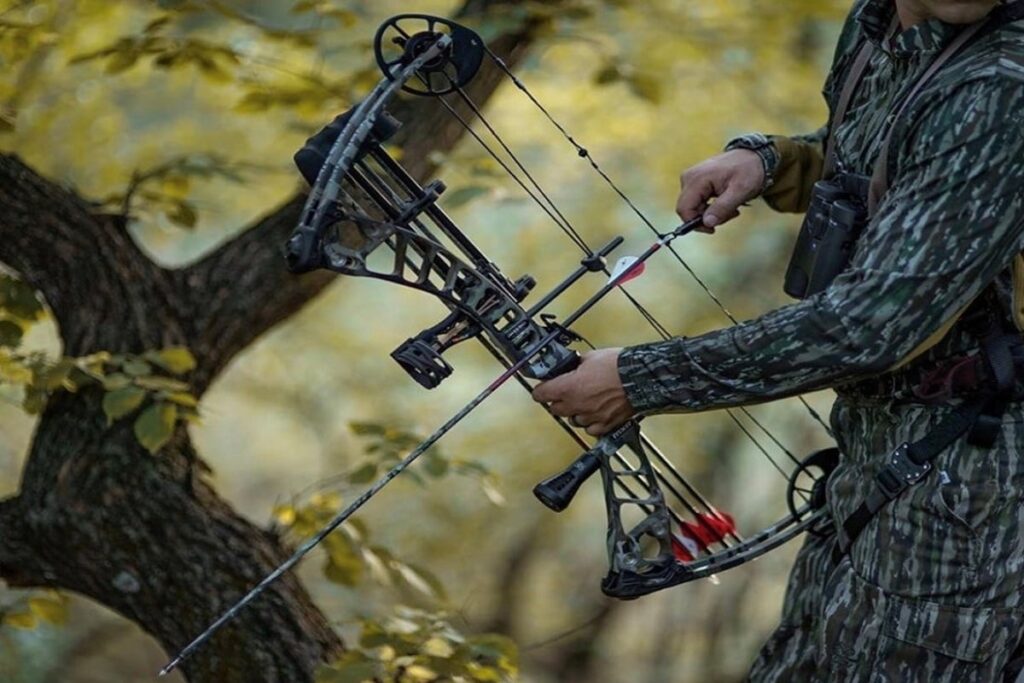The first thing you need to consider when buying a compound bow for hunting or target archery is what your poundage will be.

If you are just starting out with all of this, then I would suggest getting one that has an adjustable draw length and/or draw weight (the latter being more important).
This way, you can start off in the right direction without having to hunt around for something that fits your needs.
There is nothing worse than trying to finding out that you cant adjust the draw weight on your compound bow after it’s been months since you bought it!
- What Is a Bow Draw Weight?
- Steps to Adjust the Draw Weight on a Compound Bow
- How to Raise Draw Weight To Maximum Poundage
- What Effect Does Changing the Draw Weight Have on the Sights?
- Recommended Draw Weight
- How to Determine the Right Draw Weight for You
- Taking Safety Measures When Tuning Your Compound Bow
- Wrap Up
So here we go…
What Is a Bow Draw Weight?
Basically, draw weight refers to how much pressure is put on the string by your arms as they pull the handle towards them.
As such, there are two types of weights.
Types of Bow Draw Weights
One type comes attached directly to the bow, while others come from a separate draw plate assembly.
In either case, draw weight can vary depending on where along the limb shaft your grip point is located.
Therefore, if you have a compound bow with fixed draw lengths, it’s impossible to change the overall pounds-per-foot rating of the unit because each foot has a specific distance between the grip and tip ends.
For instance, let us assume that the total draw length of our particular model is 40 inches. We also know that at 15 inches down along the forearm from the tip end of the bow, the bow weighs approximately 120 pounds.
That means that any adjustments must take place somewhere else along the limbs. Herein lies the issue.
Maintaining the Balance of Your Bow
How do you choose which part of the limb to make heavier so that the final result still maintains its original balance?
In order to achieve maximum performance, most hunters prefer to use their full potential pounds-for-feet rather than simply adding additional weight to the bow.
However, if you’re shooting arrows at close range, say under 60 yards, or want to shoot up into the 70-yard area, you may wish to increase your draw weight.
Increasing Your Draw Affects Your Center of Gravity
But remember, doing so too greatly alters the center of gravity of the entire system. Also, keep these factors in mind:
If you plan to mount your bow on a wall, you’ll probably want to buy a shorter model. It’s easier to get a good shot using short bows, especially at long ranges.
A longer bow tends to produce better accuracy at closer distances. You should also note that even though longer bows generally weigh less, the lighter ones tend to perform best over time.
Try Different Models Until You Find the Perfect Fit for You
Keep in mind that some manufacturers offer several options within a given line, allowing you to customize your own package.
Most people who purchase compound bows expect to get about 400 shots per box before needing to replace them.
Some brands last longer than others, but many experts agree that you shouldn’t spend more than $100-$150 per year on replacement parts.
Steps to Adjust the Draw Weight on a Compound Bow
Before going through every step required to alter a compound bow’s draw weight, remember that altering the draw weight on a compound bow requires special tools.
Most companies provide a set of screwdrivers and other items needed to access certain areas of the bow.
1. Get a Screwdriver
Once inside the components, however, you’ll need to remove the screws holding the upper section together.
2. Move the Tension Rod
Next, slide the tension rod back and forth along the threaded portion of the mounting post until the desired weight is achieved.
3. Reinstall Everything and Check
Afterward, reinstall everything exactly as it was prior to making changes. Now repeat steps 1 and 2 again, only now add an additional pound to the lower half of the bow.
4. Be Careful
Do not exceed 100 percent of the pounds-per-foot value stated above. Otherwise, you could potentially damage the bow beyond repair.
How to Raise Draw Weight To Maximum Poundage
After completing the previous three steps, you should have increased the pounds-per-foot rate to 125% of the original figure.
At this point, you can begin raising the draw weight of your compound bow. Remember, only raise the pounds-per-foot incrementally.
When you reach 175%, stop increasing the pounds per foot. Instead, move on to the next step.
Once you’ve reached this stage, you can continue adjusting the draw weight upwards. Again, never exceed the original figures.
If done properly, you won’t see any negative effects. Before proceeding further, ensure that your safety equipment is secure and ready to go.
Always wear proper clothing and eye protection whenever working on a compound bow. And don’t forget to read the owner’s manual thoroughly. Then follow the instructions listed carefully.
What Effect Does Changing the Draw Weight Have on the Sights?
For those who aren’t familiar with the sights of a compound bow, here’s a brief explanation.
Sighting in a compound bow involves aligning various pins in the sight window with the arrow nocks on the front of the riser.
These pins contain tiny pegs that protrude slightly past their respective holes. They help hold the sighting device steady while aiming.
Since the pin positions remain unchanged regardless of whether you switch draw weights, changing draw weight doesn’t affect the sights whatsoever.
However, increasing the pounds-per-foot increases the amount of force exerted against the strings during release.
Consequently, greater forces cause frayed fibers, leading to reduced performance. Furthermore, higher pounds-per-foot rates reduce the life span of the bow considerably.
Recommended Draw Weight
As mentioned earlier, everyone’s body reacts differently to varying amounts of pressure placed upon it.
Generally speaking, beginners should aim for a bow that delivers anywhere from 30%–40% of its ultimate power rating.
More experienced shooters can opt for 50%-70%. Finally, advanced users should look for units capable of delivering 80% or more of their rated strength.
Of course, no matter what level of skill you possess, always consult a professional regarding which bow is appropriate for you.
So now you know how to alter the draw weight of a compound bow. Just remember that you can only alter the pounds-per-foot ratio. Never exceed 60% of the original number. Doing so can ruin the bow permanently.
How to Determine the Right Draw Weight for You
Sit on a high chair and pull back the bowstring with your feet off the ground to determine your ideal weight.
Try to spot the location that is experiencing the most resistance when you pull the bowstring back.
The draw weight is set appropriately if, following the whole draw, you feel at ease with the poundage. It’s crucial to always aim for the draw weight at which you feel most at ease.
The typical standard weight can be used as a guide if you’re unsure of the draw weight to start with:
| Age / Skill Level | Body Weight (lbs) | Draw Weight (lbs) |
|---|---|---|
| Kids | 45-70 | 10-15 |
| Teenagers | 70-100 | 15-30 |
| Young Adults | 100–130 | 30-40 |
| Adults | 130–150 | 40-55 |
| Full Vigor Adults | 150–180 | 45–65 |
| Adult Bow Hunters | 150-180 | 50-70 |
Do not shoot a bow if you are uncomfortable with the amount of power required to draw it, as this might affect the accuracy and even result in injury. Keep in mind that these are only guidelines.
You might need to adjust your draw weight over time, depending on how your upper body strength, experience, and shooting style change.
As a beginning archer gains strength and/or stature, he or she will need to increase the draw weight (and frequently the draw length) of the bow.
Similar to this, a target bow’s draw weight may need to be increased for hunting, especially if a huge animal is to be taken down.
Taking Safety Measures When Tuning Your Compound Bow
Make sure to exercise caution when tightening the limb bolts in order to adjust the draw weight. The bowstrings or cams could break if the limb bolts were overtightened.
It is crucial that you consult your user’s manual to learn how many times you may tighten the limb bolt before it becomes damaged.
Check to make sure the locking screws are securely fastened once you have finished adjusting your compound bow.
The limb bolts won’t unintentionally disengage while utilizing the compound bow as a result.
Wrap Up
It’s crucial to note that you will need to modify your compound bow multiple times before you find the perfect size as you get more archery skills.
Additionally, compound bows differ from one another, so you won’t feel comfortable using the same draw weight on each type of bow.

